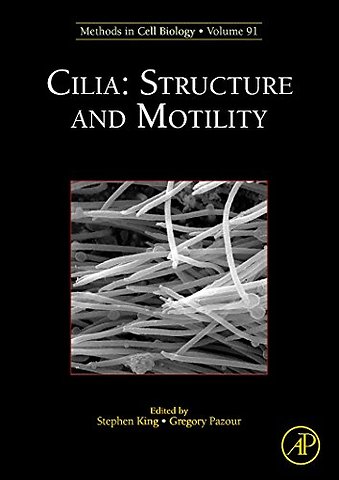<p>1. RNAi approaches to axonemal motor function in trypanosomes (Hill)<br>2. Homologous recombination to knock out dynein genes in Tetrahymena (Gaertig)<br>3. RNAi in Chlamydomonas (Cerutti)<br>4. Planarians as a model system for analysis of ciliary assembly/motility (Rompolas)<br>5. Role of nucleotides in dynein function (Shingyoji)<br>6. Protein modification to probe dynein interactions + purification and identification of crosslinked dynein products (Sakato)<br>7. Analysis of redox-sensitive dynein components (Wakabayashi)<br>8. Purification of dyneins from Chlamydomonas and analysis of dynein-dynein linkers (Kamiya/King)<br>9. Kinase/phosphatase-mediated control of dynein function (Sale)<br>10. Central pair MT complex and associated kinesins (Mitchell)<br>11. Calcium regulation of axonemal function In vitro motility assays (Smith)<br>12. Identification and analysis of dynein regulatory complex components (Porter)<br>13. Isolation and analysis of radial spoke proteins (Yang)<br>14. Purification of dyneins from other model organisms: Ciona, sea urchin, fish (Inaba)<br>15. Rescue of mutant phenotypes by protein electroporation (Kamiya Lab)<br>16. Tubulin/Dynein interactions (Raff)<br>17. Measurement of beat frequency and swimming velocity Cell model reactivation in vitro assays of dynein function (Kamiya)<br>18. Live imaging of ependymal cilia (Lechtreck/Witman)<br>19. Immunogold labeling of axonemal components in situ + flat embedding (Geimer)<br>20. CryoEM approaches to axonemal organization (Nicastro)<br>21. CryoEM of dynein-microtubule complexes (Oda/Kikkawa)<br>22. Bioinformatic approaches to dynein HC classification (Yagi)<br>23. Bioinformatics of non-motor dynein components (Asai)<br>24. Biophysical approaches to dynein mechanism (Sutoh)<br>25. Chlamydomonas flagellar beat analysis (Foster)<br>26. Biophysical measurements of motor function (step size/force production) SAXS of axonemes (Toba/Oiwa)</p> <p>Cryo-Electron Microscope Tomography to Study Axonemal</p> <p>Organization</p> <p>Daniela Nicastro</p> <p>2. Electron Microscopic Imaging and Analysis of Isolated</p> <p>Dynein Particles</p> <p>Anthony J. Roberts and Stan A. Burgess</p> <p>3. Immunogold Labeling of Flagellar Components In Situ</p> <p>Stefan Geimer</p> <p>4. Scanning Electron Microscopy to Examine Cells and Organs</p> <p>Jovenal T. SanAgustin, John A. Follit, Gregory Hendricks, and Gregory J. Pazour</p> <p>5. X-ray Fiber Diffraction Studies on Flagellar Axonemes</p> <p>Kazuhiro Oiwa, Shinji Kamimura, and Hiroyuki Iwamoto</p> <p>6. Markers for Neuronal Cilia</p> <p>Jacqueline S. Domire and Kirk Mykytyn</p> <p>7. Immunofluorescence Staining of Ciliated Respiratory Epithelial Cells</p> <p>Heymut Omran and Niki T. Loges</p> <p>8. Immunoprecipitation to Examine Protein Complexes</p> <p>Gregory J. Pazour</p> <p>9. Tandem Affinity Purification of Ciliopathy-Associated Protein</p> <p>Complexes</p> <p>Karsten Boldt, Jeroen van Reeuwijk, Christian Johannes Gloeckner,</p> <p>Marius Ueffing, and Ronald Roepman</p> <p>10. Crosslinking Methods: Purification and Analysis of Crosslinked Dynein Products</p> <p>Miho Sakato</p> <p>11. Analysis of the Ciliary/Flagellar Beating of Chlamydomonas</p> <p>Kenneth W. Foster</p> <p>12. Assays of Cell and Axonemal Motility in Chlamydomonas reinhardtii</p> <p>Ritsu Kamiya</p> <p>13. High-Speed Digital Imaging of Ependymal Cilia in the Murine Brain</p> <p>Karl-Ferdinand Lechtreck, Michael J. Sanderson, and George B. Witman</p> <p>14. Observation of Nodal Cilia Movement and Measurement of Nodal Flow</p> <p>Yasushi Okada and Nobutaka Hirokawa</p> <p>15. Modification of Mouse Nodal Flow by Applying Artificial Flow</p> <p>Shigenori Nonaka</p> <p>16. Measuring Cilium-Induced Ca2þ Increases in Cultured Renal Epithelia</p> <p>Helle A. Praetorius</p>
